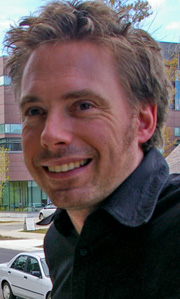Against the backdrop of a city on the verge of financial ruin and staring down the possibility of an even bigger disconnect from its Canadian cousins thanks to a recently approved U.S. budget bill, a group of artists and researchers will gather here this weekend looking for ways to encourage people to think of Detroit and Windsor as a singular cross-border metropolitan environment.

Michael Darroch. |
“With the great deal of attention that Detroit receives as a site of potential change, it’s not really thought of as a border city,” said Michael Darroch, a professor of media art histories and director of the IN/TERMINUS art and research collective. “Its relationship to Windsor and to Canada isn’t really mentioned that often. We want to start that conversation.”
This weekend, the organization is co-organizing a symposium at the Art Gallery of Windsor called Diversions: Detroit-Windsor Conversations on Borders, Traffic, and Circulation, along with Lee Rodney’s Border Bookmobile Project, Srimoyee Mitra, curator of contemporary art at the Art Gallery of Windsor, and the McGill-based Media and Urban Life project.
Besides a number of free panel discussions that are open to the public, the group will cross the border Saturday for a bus tour of Detroit – hosted by Dylan Miner, a border-crossing artist, activist, historian, curator and professor at Michigan State University – and then spend the night there. On Sunday, they’ll meet again to talk about new ways to reconsider the “obstacles and mobilities that have emerged” in the Detroit-Windsor urban locale.
Darroch said the point of IN/TERMINUS, born out of a similar symposium two years ago and supported by the University’s Strategic Priority Fund, is to conduct interdisciplinary research at the intersection where creative art meets science and technology, with a specific interest in the ecology of cities, and the social and cultural fabrics of city life.
“We’re creating a space to think about Windsor as an interesting urban environment, a concept which we felt had been neglected,” he said. “In terms of thinking about the culture of the place, we felt the university needed a central space to bring various strands of urban, cultural, and creative research together.”
The group couldn’t be going to Detroit at a more historic and critical time. Last Friday, Michigan Governor Rick Snyder declared Detroit in a state of financial emergency and suggested he may point an emergency manager within the next 10 days. At the same time, lawmakers in Washington approved a sequestration bill which will result in the slashing of more than 5,000 border guards, which will have “serious consequences to the flow of trade and travel at our nation’s ports of entry,” U.S. Homeland Security Secretary Janet Napolitano warned.
Despite the city’s woes, being at a critical juncture in Detroit’s history offers a rare opportunity to reimagine it in the context of its relationship to the border and to Windsor, Dr. Darroch said. While Windsor’s urban character has been closely tied to Detroit’s rise and fall, he added, much of the artistic and intellectual activity from Detroit focuses on the city’s internal divisions while the international boundary on its southern edge remains ignored.
“Largely due to the fact that it’s such a complicated place internally, Windsor is fairly low on its radar,” he said.

